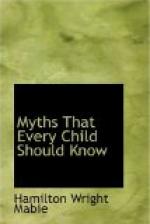The sun, which vanquished the darkness, put out the stars, drove the cold to the far north, called back the flowers, made the fields fertile, awoke men from sleep and filled them with courage and hope, was the centre of mythology, and appears and reappears in a thousand stories in many parts of the world, and in all kinds of disguises. Now he is the most beautiful and noble of the Greek gods, Apollo; now he is Odin, with a single eye; now he is Hercules, the hero, with his twelve great labours for the good of men; now he is Oedipus, who met the Sphinx and solved her riddle. In the early times men saw how everything in the world about them drew its strength and beauty from the sun; how the sun warmed the earth and made the crops grow; how it brought gladness and hope and inspiration to men; and they made it the centre of the great world story, the foremost hero of the great world play. For the myths form a poetical explanation of the earth, the sea, the sky, and of the life of man in this wonderful universe, and each great myth was a chapter in a story which endowed day and night, summer and winter, sun, moon, stars, winds, clouds, fire, with life, and made them actors in the mysterious drama of the world. Our Norse forefathers thought of themselves always as looking on at a terrible fight between the gods, who were light and heat and fruitfulness, revealed in the beauty of day and the splendour of summer, and the giants, who were darkness, cold and barrenness, revealed in the gloom of night and the desolation of winter. To the Norseman, as to the Greek, the Roman, the Hindu and other primitive peoples, the world was the scene of a great struggle, the stage on which gods, demons, and heroes were contending for supremacy; and they told that story in a thousand different ways. Every myth is a chapter in that story, and differs from other stories and legends because it is an explanation of something that happened in earth, sea, or sky.
If the men who created the myths had set to work to make wonder tales as stories are sometimes made to instruct while they entertain children, they would have left a mass of very dull tales which few people would have cared to read. They had no idea of doing anything so artificial and mechanical; they made these old stories because all life was a story to them, full of splendid or terrible figures moving across the sky or through the sea and in the depths of the woods, and whichever way they looked they saw or thought they saw mysterious and wonderful things going on. They were as much interested in their world as we are in ours; we write hundreds of scientific books every year to explain our world; they told hundreds of stories every year to explain theirs.
This selection represents the work of several authors, and does not, therefore, preserve uniformity of style. It is probably better for the young reader that the Greek Myths should come from one hand, and the Norse Myths from another. The classical work of Hawthorne has been generously drawn upon. No change of any kind has been made in the text, but the introductions connecting one myth with another have been omitted.




